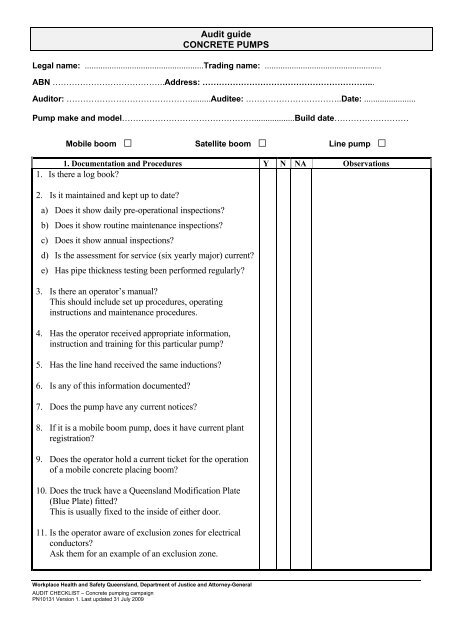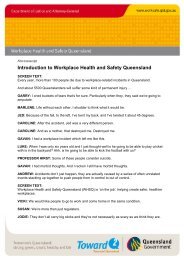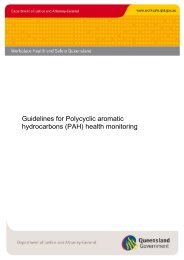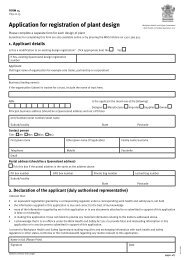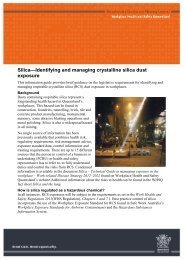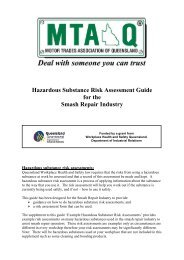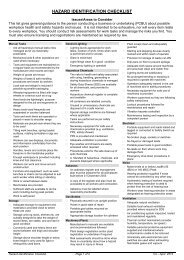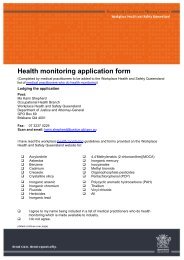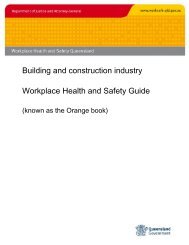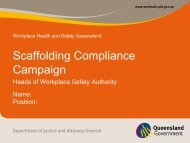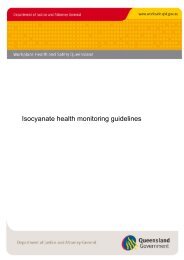Audit Guide CONCRETE PUMPS
Audit Guide CONCRETE PUMPS
Audit Guide CONCRETE PUMPS
Create successful ePaper yourself
Turn your PDF publications into a flip-book with our unique Google optimized e-Paper software.
<strong>Audit</strong> guide<strong>CONCRETE</strong> <strong>PUMPS</strong>Legal name: .....................................................Trading name: ....................................................ABN …………………………………..Address: ……………………………………………………...<strong>Audit</strong>or: ……………………………………….........<strong>Audit</strong>ee: ……………………………..Date: .......................Pump make and model…………………………………………..................Build date………………………Mobile boom □ Satellite boom □ Line pump □1. Documentation and Procedures Y N NA Observations1. Is there a log book?2. Is it maintained and kept up to date?a) Does it show daily pre-operational inspections?b) Does it show routine maintenance inspections?c) Does it show annual inspections?d) Is the assessment for service (six yearly major) current?e) Has pipe thickness testing been performed regularly?3. Is there an operator’s manual?This should include set up procedures, operatinginstructions and maintenance procedures.4. Has the operator received appropriate information,instruction and training for this particular pump?5. Has the line hand received the same inductions?6. Is any of this information documented?7. Does the pump have any current notices?8. If it is a mobile boom pump, does it have current plantregistration?9. Does the operator hold a current ticket for the operationof a mobile concrete placing boom?10. Does the truck have a Queensland Modification Plate(Blue Plate) fitted?This is usually fixed to the inside of either door.11. Is the operator aware of exclusion zones for electricalconductors?Ask them for an example of an exclusion zone.Workplace Health and Safety Queensland, Department of Justice and Attorney-GeneralAUDIT CHECKLIST – Concrete pumping campaignPN10131 Version 1. Last updated 31 July 2009
<strong>Audit</strong> guide<strong>CONCRETE</strong> <strong>PUMPS</strong>12. Is there a work method statement?If the answer to Q 8 and 9 is N, then potentially aninfringement notice and a prohibition notice can beissued for either.Q 10 is a Queensland Transport requirement and if thereis no Blue Plate fitted, then the pump module may nothave been fitted by a competent person – QueenslandTransport may be notified. It is up to the inspector toissue notices for all other N answers.2. Condition and Operation Y N NA Observations1. Are warning and operational signs fitted?2. Is there a horn/warning device fitted that can befunctioned from the ground near the hopper area?3. Are there easily accessible emergency stops fitted?4. Is there easy, safe access onto the pump?5. Are there any slip, trip or protrusion hazards?6. Do the air reservoir tanks have a pressure gauge fitted?7. Is there a blow off or safety valve fitted on the tanks?8. Is there an indication that the module mounting boltsare loose or missing?9. Are there any visible cracks in the chassis or module?10. Are all controls for the boom and outrigger operationclearly marked and functional?11. Are all pressure gauges and controls clearly marked andfunctional on the control panel?12. Are safety chains fitted to the drop hose and reducer?13. Does the drop hose comply with the pumpmanufacturers’ specifications?This will be stated by the manufacturer and should beclearly marked at the end of the boom. Maximum drophose length is usually 4 m for 125 mm diameter hose.14. Are all retaining clips fitted to all quick release pipeclamps?15. Do the clamps appear to be in good condition?Workplace Health and Safety Queensland, Department of Justice and Attorney-GeneralAUDIT CHECKLIST – Concrete pumping campaignPN10131 Version 1. Last updated 31 July 2009
<strong>Audit</strong> guide<strong>CONCRETE</strong> <strong>PUMPS</strong>16. Are the clamps marked with their maximum operatingpressure?17. Are high pressure clamps used at the hopper end?18. Does the pipeline appear to be in good condition?19. Look for dents and pinholes that may be leaking slurry,especially in reducers.20. Are all rubber delivery hoses in good condition?21. Are there any visible cracks in the boom?This will be hard to determine with the boom operating.22. Are there any signs that any boom pins are worn or arethere any missing retainers or keepers?23. Are there any visible oil leaks?24. Are there any damaged hydraulic hoses?25. Are there any fans, shafts, pulleys or gears unguarded?26. Are the stabiliser legs/outriggers in good condition?Look at the foot pads, pins, check valves and hoses.Look for any noticeable damage or wear. Ensure thatthe outriggers are locked in when extended.27. Are pads/timbers provided under outrigger feet?28. Can the outriggers be securely locked in place when thepump is in travel mode?29. If short legging is used does the manufacturer allow thisand is there a documented procedure?30. If there is a risk of collision with the boom, is there aprocedure to help prevent this?31. Is there a hopper grill in place and does it provideadequate protection from all moving parts (gap≤ 75 mm)?32. Do the agitator paddles and valve system stop when thehopper grill is lifted?33. Does the accumulator drop all pressure when the grill islifted?Workplace Health and Safety Queensland, Department of Justice and Attorney-GeneralAUDIT CHECKLIST – Concrete pumping campaignPN10131 Version 1. Last updated 31 July 2009
<strong>Audit</strong> guide<strong>CONCRETE</strong> <strong>PUMPS</strong>• It is up to the Inspectors’ discretion to issue appropriate notices to all N answers.• Check the overall condition of the pump. Beware of the “Dulux Reco”.• Is it obvious that regular maintenance is being performed? i.e. fresh grease around nipples and pins,hydraulic oil levels are okay, no missing nuts and bolts, and nothing held together by tie wire andduct tape.• Discolouration around bolt heads and washers is a good indication that the bolts are loose.• If the overall condition of the unit is obviously poor and it is way past or never had a major sixyearly inspection and there is a risk of failure to any part of the pump, then its use should beprohibited until it has been certified and documented by a competent person. This is to be certifiedby a professional engineer.• Make sure that the operator is aware that emergency stops are there for an emergency. They are notthere for the agitator driver to shut the pump down when his truck is empty or the hopper is gettinglow.• Drivers of pre-mixed concrete delivery trucks should not be considered workers for pumpingoperations, unless trained to carry out this function and authorised to act in this capacity by theiremployer.• The concrete pump operator should never be operating the controls for the pump and alsoperforming the task of the line hand at the same time.• The operator should arrange for an alternative competent person to attend to the pump if he isrequired to work away from the pump. He should have a clear view of both the line hand and thehopper. If unable to view both, then an additional competent person, other than the concrete deliverydriver should be located at the hopper and be responsible for stopping the pump.Comments:..............................................................................................……………………….....................................................................................................................................……………………………......................................................................................................................................................................................................................................................................………………………………………………………..………………………………….……………………………………………………………………………...………………………………………………………………………………………………………………………………………………………………………………………………………………………………………………………………………………………………………………………………………………………………………………………………………………………………………………………………………………………………………………………………………………………………………………………………………………………………………………………………………………………………………………………………………………………………………………………………………………………………………………………………………………………………………………………………………………………………………………………………………………………………………………………………………………………………………………………………………………………………………………………………………………………………………………………………………………………………………………………………………………………………………………………………………………………………………………………………………………………………………………………………………………………………………………………………………………………………………………………………………………………………………………………………………………………………………………………………………………………………………………NOTE: Detailed examination of every hazard is not possible nor can the audit ensure that the preventative systems found to be effective today will remaineffective tomorrow or in six months or two years time. These responsibilities rest primarily with workplace management. The audit represents the auditorsopinions about observations made and does NOT indicate compliance with the Workplace Health and Safety Act 1995.Workplace Health and Safety Queensland, Department of Justice and Attorney-GeneralAUDIT CHECKLIST – Concrete pumping campaignPN10131 Version 1. Last updated 31 July 2009


